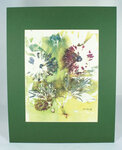



Cheasanee Hetherington
For The Reflector
Amazing colors are hidden in nature, and Battle Ground artist Kim Wessa enjoys discovering them through eco printing.
Self-taught, Wessa has spent the last nine years studying the art. By using botanicals and mordants used to set the dyes, she creates colorful art inspired by nature. Wessa delights in sharing her craft, and teaching others how to create their own artworks at Eco Prints from Nature.
“Beauty is locked inside the plants,” Wessa said. “You never know what you’re going to get.”
Wessa first encountered eco printing while visiting Art by the Sea, located in Bandon, Oregon. Eco-printed artwork by Barbara Lebiedzik was displayed in the gallery and inspired Wessa to pursue the craft.
For Wessa, eco printing is a delicate process requiring precise botanical placement and mordant mixtures. Wessa continues to make new discoveries in her medium, though she has been practicing eco printing for nine years.
“I’m self-taught, so this is just how I do it,” Wessa said. “I always tell people there’s a lot of ways to do it.”
Wessa’s process of eco printing is similar for both fabric and paper. The base material is first combined with botanicals and mordant. Fabrics are rolled around a wooden dowel, while paper artworks are pressed between metal plates. The materials are steamed, and the heat and moisture release the natural dyes within the flowers, completing the artwork.
Over the years, Wessa has experimented with many different materials. Any paper can be used in eco printing, though she often uses watercolor paper. Wool, cotton, muslin and silk are common fabrics in Wessa’s art studio.
A myriad of botanicals can be used in eco printing. Wessa has experimented with many plants, including dahlias, roses, coleus and red maple leaves. The botanicals in her artworks are grown and foraged on her property.
Mordant is critical to the eco printing process, Wessa said. Mordants set the dye and intensify the colors. Wessa uses iron and alum mordants in hers. Iron results in dark colors, while alum creates brighter colors, Wessa said.
The dyes extracted from the plant during eco printing are always changing. The same plant printed during one month may not print the same the next. The uncertainty about the final product, and the excitement of unveiling the artwork after steaming, are part of the joy of eco printing, Wessa said.
“The colors are constantly changing,” Wessa said. “It’s God’s art with my hands.”
As a self-taught artist, Wessa keeps a record of her experimental successes and failures. Creating the right mixture of mordant and well-printing botanicals took years of trial and error.
“I got just enough good results to keep me going,” Wessa said.
Wessa had considered some of her first projects to be failures. She recently rediscovered a muslin towel she printed nine years ago. When Wessa first began printing she wanted to create practical and usable items. She was initially disappointed and felt that no one would like to use the dye-stained muslin towel she created. After rediscovering the artwork, it became a cherished display piece.
For beginners interested in eco printing at home, Wessa encourages them to begin with fabric squares. A starter eco printing setup requires a pair of ceramic tiles, wax paper, metal clamps, mordant, botanicals and a square of fabric. After preparing and pressing the fabric, any steamer can be used to set the botanical dyes within the art piece.
Wessa cautions artists to practice safety during eco printing for the sake of their health. Mordants contain chemicals that can be dangerous. Gloves should be used while working with mordants, and all artwork should be steamed outdoors due to hazardous fumes.
“When I started, I started crafting in my house, and I realized it wasn’t a good idea,” Wessa said. “I never wore gloves. I’d just hand dip.”
Wessa’s research continues as she seeks new materials to use in eco printing. Some plants print well, while others fail to leave a mark. She recently tried begonia leaves for the first time. To her surprise, the leaves left brilliant pink imprints on the artwork.
Wessa’s art is available for purchase on her website. She also offers eco printing classes, taught at her home studio. For more information, visit her website ecoprintsfromnature.com or call 360-798-9976.